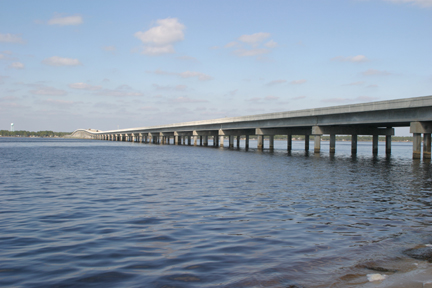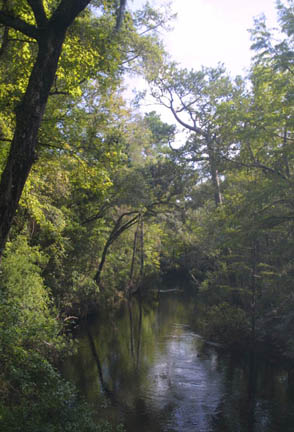|
History Animals & Plants Natural Communities Coastal Dry Uplands Upland Mesic Freshwater Marshes Forested Wetlands Fresh Water Estuaries |
Natural Communities and Habitats:
Fresh Water - Rivers and Streams
The personality of a river is a product of the land it travels through. The ARROW region is loaded with rivers. Getting to know a river means getting to know the land, too.
Florida's streams and rivers can be divided into four basic types:
Alluvial rivers, like the Apalachicola and Ochlockonee, are muddy. They carry a lot of sand, silt, and clay (see Soils), collectively called alluvium, that is transported into the river by surface runoff. Alluvial rivers tend to wander around the landscape, leaving behind oxbow lakes and abandoned channels. The river dumps sediments in some spots, and in others it scours its sides to collect more, eroding the banks. In times of heavy rain, particularly in winter or early spring, alluvial rivers in the ARROW region can overtop their banks and flood adjoining lands. These floods carry nutrient-rich waters into the river's floodplain and into the estuaries where the rivers empty into the Gulf of Mexico. Flooding creates habitat for many fish species, who move into flooded areas to eat and to lay eggs.
 The Ochlockonee River (photo by Karla Brandt) |
Typical plants: pickerelweed, cattails, willows, cottonwood, river birch, silver maple, and other trees along the banks; water lilies and spatterdocks in stillwater areas
Typical animals: eel, gizzard shad, madtom, pirate perch, striped bass, redbreast sunfish, warmouth, bluegill, Alabama waterdog, river frog, mud turtle, stinkpot, brown water snake, kingfisher, beaver
Rare animals: Gulf sturgeon, shoal bass, alligator, snapping turtle, alligator snapping turtle, Florida cooter, river cooter, Barbour's map turtle, Ochlockonee moccasinshell, Apalachicola floater
Blackwater streams, like the Sopchoppy and New rivers, are actually more brown than black. The color comes from fallen leaves that soak in the water, the same process -- and the same color -- that you get from soaking tea leaves in water. The name of the stain is tannic acid.
 The Sopchoppy River (photo by Karla Brandt) |
Typical plants: golden club, smartweed, sedges, and grasses
Typical animals: longnose gar, gizzard shad, threadfin shad, redfin pickerel, chain pickerel, blacktail shiner, chubsucker, channel catfish, banded topminnow, pygmy killifish, mosquitofish, mud sunfish, redbreast sunfish, dollar sunfish, stumpknocker (also called spotted sunfish), spotted bass, black crappie, Alabama waterdog, river frog, stinkpot, spiny softshell, redbelly water snake, brown water snake, beaver
Rare animals: alligator, snapping turtle, alligator snapping turtle, river cooter, Florida cooter, peninsula cooter
Seepage streams, such as those that drain from ravines into the east side of the northern Apalachicola and Ochlockonee rivers, usually have clear or very lightly tinted waters. Rain falls on the hilltops and filters downward until it hits a layer it cannot penetrate. It then moves sideways and eventually seeps out of the hillside, forming a stream.
Typical plants: filamentous green algae, mosses, ferns and liverworts may grow in clumps at the water's edge; where there's enough sunlight, narrow bands of spatterdocks, goldenclub, spikerush, and pondweeds may occur along the shorelines, and tape grass and pondweed may grow in the streambed
Typical animals: sailfin shiner, creek chub, mosquitofish, speckled madtom, brown darter, blackbanded darter, amphiuma, Alabama waterdog, southern dusky salamander, two-lined salamander, mud salamander, southern red salamander, bronze frog, loggerhead musk turtle, rainbow snake, redbelly water snake, and brown water snake
Rare animals: snapping turtle
Spring runs, like the Chipola, Wakulla, St. Marks, and Aucilla rivers, emerge from springs (see Karst). Their waters can be so clear that you can see all the way to the stream's bottom, but they can also be clouded or darkened when heavy rains wash dead leaves, oil and gas from highways, and anything else on the ground surface into the springs or into the channels that feed water to the springs.
Typical plants: tape grass, wild rice, giant cutgrass, arrowheads, southern naiads, pondweeds; chara, also known as muskweed (a large alga)
Typical animals: mollusks, stoneflies, mayflies, caddisflies, loggerhead musk turtle, rainbow snake, redbelly water snake, brown water snake, and many fishes
Rare animals: American alligator, alligator snapping turtle, Suwannee cooter, limpkin
Sources:
Clewell, A.F. 1991. Florida rivers: the physical environment. Pp. 17-30 in Livingston, R.J. (ed.). The rivers of Florida. Springer-Verlag, New York.
Florida Natural Areas Inventory and Florida Department of Natural Resources. 1990. Guide to the natural communities of Florida. Florida Natural Areas Inventory, Tallahasse, FL. Available at FNAI's website.
Glbert, T., and B. Stys. 2004. Descriptions of vegetation and land cover types mapped using Landsat imagery. Florida Fish and Wildlife Conservation Commission, Office of Environmental Services, Tallahassee, FL. Available at Florida Vegetation and Land Cover - 2003.
Mossa, J. 1998. Surface water. Pp. 64-81 in Fernald, E.A., and E.D. Purdum (eds.). Water resources atlas of Florida. Institute of Science and Pubic Affairs, Florida State University, Tallahassee.
Note: The content of the website has not been updated since 2005. The site remains online for it's value as legacy content and is unlikely to be updated.